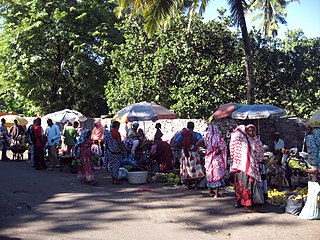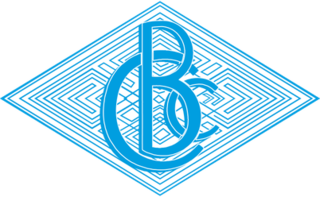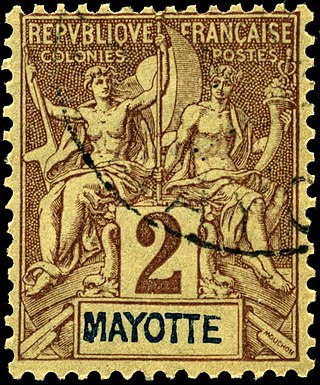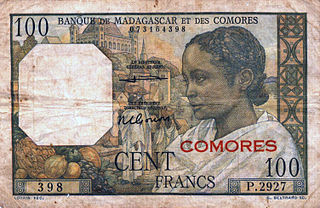
The CFA franc is the name of two currencies, the West African CFA franc, used in eight West African countries, and the Central African CFA franc, used in six Central African countries. Although separate, the two CFA franc currencies have always been at parity and are effectively interchangeable. The ISO currency codes are XAF for the Central African CFA franc and XOF for the West African CFA franc. On 22 December 2019, it was announced that the West African currency would be reformed and replaced by an independent currency to be called Eco.

The economy of the Comoros is based on subsistence agriculture and fishing. Comoros has inadequate transportation links, a young and rapidly increasing population, and few natural resources. The low educational level of the labor force contributes to a subsistence level of economic activity, high unemployment, and a heavy dependence on foreign grants and technical assistance. The Comoros, with an estimated gross domestic product (GDP) per capita income of about $700, is among the world's poorest and least developed nations. Although the quality of the land differs from island to island, most of the widespread lava-encrusted soil formations are unsuited to agriculture. As a result, most of the inhabitants make their living from subsistence agriculture and fishing. Average wages in 2007 hover around $3–4 per day.
The ouguiya, at one time spelled "ougiya", is the currency of Mauritania. Each ouguiya constitutes five khoums. As such it is one of two circulating currencies, along with the Malagasy ariary, whose division units are not based on a power of ten.

A currency symbol or currency sign is a graphic symbol used to denote a currency unit. Usually it is defined by a monetary authority, such as the national central bank for the currency concerned.

The ariary is the currency of Madagascar. It is notionally subdivided into 5 iraimbilanja and is one of only two non-decimal currencies currently circulating. The names ariary and iraimbilanja derive from the pre-colonial currency, with ariary being the name for a silver dollar. Iraimbilanja means literally "one iron weight" and was the name of an old coin worth 1⁄5 of an ariary. However, as of May 2023, the unit is effectively obsolete since the iraimbilanja has practically no purchasing power, and the coins have fallen into disuse.
The iraimbilanja is the divisory currency unit of Madagascar, being equal to one fifth of an ariary.

The franc was the currency of Madagascar until 1 January 2005. It was subdivided into 100 centimes. In Malagasy the corresponding term for the franc is iraimbilanja, and five Malagasy francs is called ariary.
The franc is the official currency of Comoros. It is nominally subdivided into 100 centimes, although no centime denominations have ever been issued.

The Banque de l'Afrique Occidentale was a French bank established in 1901 to issue currency for the colonies of French West Africa.

The Central African CFA franc is the currency of six independent states in Central Africa: Cameroon, Central African Republic, Chad, Republic of the Congo, Equatorial Guinea and Gabon. These six countries have a combined population of 55.2 million people, and a combined GDP of over US$100 billion.

The West African CFA franc is the currency used by eight independent states in West Africa which make up the West African Economic and Monetary Union : Benin, Burkina Faso, Côte d'Ivoire, Guinea-Bissau, Mali, Niger, Senegal and Togo. These eight countries had a combined population of 105.7 million people in 2014, and a combined GDP of US$128.6 billion as of 2018.

The Central Bank of West African States is a central bank serving the eight west African countries which share the common West African CFA franc currency and comprise the West African Economic and Monetary Union.

The Central Bank of the Congo is the central bank of the Democratic Republic of the Congo. The bank's main offices are on Boulevard Colonel Tshatshi in La Gombe in Kinshasa.

The Bank of the Republic of Burundi is the central bank of Burundi. The bank was established in 1966 and its offices are in Bujumbura.

The Central Bank of the Comros is the central bank of the Comoros, a group of islands in the Indian Ocean.

This is an overview of the postage stamps and postal history of the Indian Ocean island of Mayotte, one of the Comoros Archipelago islands located on the south-east side of Africa.
Saïd Mohamed Ben Chech Abdallah Cheikh was the head of the Government of Comoros from 1962 until his death in 1970. Cheikh served in the French National Assembly from 1946 until 1962 and was also the president of the Parti Vert.
This is a list of coins of Madagascar.

The Banque de Madagascar, from 1946 the Banque de Madagascar et des Comores, was a bank established by the French government in 1925 to issue currency and provide credit in French Madagascar. As such, it fulfilled many of the functions of a central bank for the colony.













